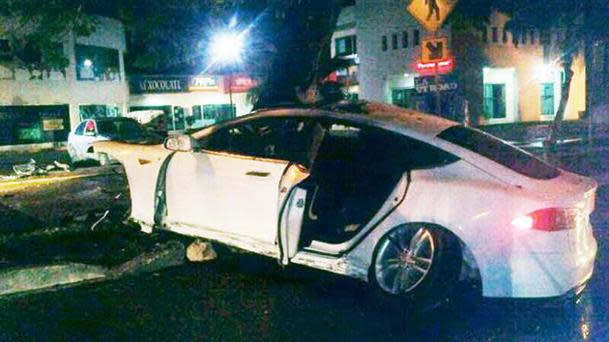 Motoramic
MotoramicSecond Tesla Model S fire sparked by crash in Mexico
The first fire in a Tesla Model S earlier this month brought about all the expected reactions; a steep sell-off by Wall Street in its volatile shares, followed by a spirited defense of electric vehicle technology from Tesla CEO Elon Musk. Last week, U.S. auto safety officials said they agreed with Musk's assessment that the fire was due to road debris, and said no official investigation was necessary — a fairly typical step given that NHTSA only investigates a fraction of the 180,000 vehicle fires in the United States every year.
So what to make of the second report of a Tesla Model S crashing and catching fire, in far different circumstances?
Unearthed by Axis of Oversteer, the crash happened Oct. 18 in Merida, a city in the northern Yucatan Peninsula of Mexico. According to local news reports, the Tesla was speeding through a roundabout at 4 a.m. when it hit a raised pedestrian crossing and briefly took flight before crashing into a wall and tree. The driver and perhaps a couple of passengers quickly left the scene, leaving the Tesla to burn for several minutes before firefighters arrived. (Warning: if you understand Spanish, there's some rough language in the video below).
As the video shows, the Model S burns freely, and in doing so sends off a couple secondary explosions before firefighters arrive to douse the flames. The fire appears more intense than the one in Washington State earlier this month, although it does stay contained to the front of the vehicle, which comports with Musk's assertions that the firewalls in the Model S battery compartment underneath the car keep flames from spreading.
Tesla says it's been in touch with the driver who fled the scene, and he's ready to get behind the wheel again:
We were able to contact the driver quickly and are pleased that he is safe. This was a significant accident where the car was traveling at such a high speed that it smashed through a concrete wall and then hit a large tree, yet the driver walked away from the car with no permanent injury. He is appreciative of the safety and performance of the car and has asked if we can expedite delivery of his next Model S.
Given the reported severity of the crash, a fire would have been likely from a gas-powered vehicle, and the fact the driver was able to flee does speak to the Tesla's crashworthiness. But the Model S remains rare enough, and first responders' experience with lithium-ion battery fires limited enough, that it will take several more cases before such events lose their notoriety.

 Yahoo Autos
Yahoo Autos 
